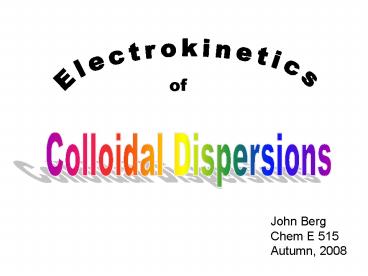Electrokinetics - PowerPoint PPT Presentation
1 / 56
Title:
Electrokinetics
Description:
Chem E 455: Surface and Colloid Science Laboratory: ... adsorption isotherm. Ci. Gi. Gi(Ci) Ionic Surfactant. ELECTRICAL DOUBLE LAYER. Helmholtz model (1879) ... – PowerPoint PPT presentation
Number of Views:1399
Avg rating:3.0/5.0
Title: Electrokinetics
1
Electrokinetics
of
Colloidal Dispersions
John Berg Chem E 515 Autumn, 2008
2
DEFINITION OF A COLLOID
Ostwald die Welt der vernachlässigten
Dimensionen
Chem E 455 Surface and Colloid Science
Laboratory Autumn and Spring Quarters
3
LYOPHOBIC COLLOIDS
4
INSTABILITY OF LYOPHOBIC COLLOIDS
5
LONG-RANGE VAN DER WAALS ATTRACTION
a
s0
6
ELECTROSTATIC REPULSION RETARDS AGGREGATION
van der Waals attraction
7
ELECTRICAL CHARGE AT AQUEOUS INTERFACES
8
(No Transcript)
9
Ionization of surface functional groups
Parking area (nm2/group) pKa
pKa1 pKa2
10
Specific adsorption of ions
11
ELECTRICAL DOUBLE LAYER
12
THE GUOY-CHAPMAN DOUBLE LAYER
13
Poisson equation (describes variation of
potential in a spatial charge distribution)
Boltzmann equation (describes variation of ion
concentration in an electric field)
14
For a single, symmetric (z-z) electrolyte
for low potentials z?0 25 mV, sinh y y,
and
Debye-Hückel approximation
15
ION CONCENTRATION PROFILES
Double layer thickness
16
EFFECT OF ELECTROLYTE CONCENTRATION ON DOUBLE
LAYER THICKNESS
17
REFINEMENTS OF DOUBLE LAYER MODEL
18
(No Transcript)
19
STERN MODEL (1924)
?0
Stern layer
Surface potential
??
Stern potential
?(x)
Stern layer thickness
?
20
STRONG SPECIFIC ADSORPTION IN THE STERN LAYER
21
ELECTROSTATIC REPULSION DEPENDS ON.
- The Stern potential, ??
- The thickness of the diffuse double layer, ?-1
22
s
Forces between particles (surfaces)
Derjaguin Landau Verwey Overbeek
When (?/kT) ? 10, ? stability
23
Controlling DLVO interactions
24
Controlling electrolyte valence and concentration
For z 2, divide all Cs by 64 for z 3, divide
all Cs by 729
25
Controlling effective Stern potential, yd
a 0.1mm T298K A21210-19J k-133Å e78.5
26
HOW CAN WE MEASURE THE STERN POTENTIAL?
27
ELECTROKINETIC EFFECTS
(electro-osmotic velocity)
V
Electro-osmosis
28
ELECTROPHORESIS
Vp electrophoretic velocity
Relevant to colloidal dispersions
29
THE ELECTROKINETIC EFFECTS
I. Externally imposed EMF produces motion 1.
Liquid moves solid is stationary 2. Solid
moves liquid is stationary
II. Externally imposed motion produces EMF
1. Liquid forced to move past solid 2.
Solid forced to move through liquid
30
- At steady state
- ?E streaming potential
- i streaming current
31
THE ELECTROKINETIC EFFECTS
I. Externally imposed EMF produces motion 1.
Liquid moves solid is stationary 2. Solid
moves liquid is stationary
II. Externally imposed motion produces EMF
1. Liquid forced to move past solid 2.
Solid forced to move through liquid
32
Dorn Effect
33
Electro-osmosis
34
Integrating once
35
Measurement of electro-osmotic velocity
Typically, V a few mm/min
36
INTERPRETATION OF THE ZETA POTENTIAL
37
ELECTROPHORESIS
Vp electrophoretic velocity
38
MEASURING ? BY MICRO-ELECROPHORESIS
Electrophoretic mobility
39
The measurement of electrophoretic mobility
Rank Brothers Mark II Microelectrophoresis System
FLOW CELL
40
and
vx 0 at y 0.2113w and 0.7887w
41
RELATING MEASURED uE TO ZETA POTENTIAL
?-1
When double layer is thin relative to particle
radius ?a gt 300
a
When double layer is thick relative to particle
radius ?a lt 0.1
42
Spherical particles 1-1 electrolyte
Hückel
Smoluchowski
43
Polyvalent electrolytes
C(?a)
?a
44
Some ion properties
Moelwyn-Hughes, E.A., Physical Chemistry, 2nd
Ed., p. 859, Pergamon Pr., Oxford, 1961.
45
Approximate solution for symmetric (z-z)
electrolytes
Good to order (?a)-1
OBrien, R.W., and Hunter, R.J., Can. J. Chem.,
59, 1878 (1981).
46
Aqueous KNO3 solutions, 25C
47
Pen Kem Model 501 Lazer Zee Meter
48
ZETA POTENTIAL AS A QC VARIABLE FOR WASTEWATER
TREATMENT
49
MORE MODERN METHODS FOR MEASURING ELECTROPHORESIS
Based on light scattering techniques
50
Quasi-elastic light scattering (QELS)
Doppler shift in frequency (line broadening) of
scattered light due to particle motion
A instrument constant D particle
diffusivity Q magnitude of the scattering vector
Measure ?w ? D ? particle size
But ?w 103 Hz and w0 1016 Hz
51
Heterodyning
52
Electrophoretic quasi-elastic light scattering
Shifted autocorrelation function
53
Photon Correlation Spectroscopy (PCS)
homodyning
Intensity pair autocorrelation function
Electrophoretic PCS
54
Laser Doppler Electrophoresis (LDE)
_
55
The Brookhaven ZetaPALSTM
56
Your assignment..
For a colloidal dispersion of spherical silica
particles of a 500 nm in an aqueous solution
of 10-4N KNO3
1. Measure the electrophoretic mobility using the
Rank Bros. Microelectrophoresis System. 2.
Measure the apparent zeta potential using the Pen
Kem Lazer Zee System.
Calculate the appropriate zeta potential from
both measurements (using the equation of
OBrien and Hunter)
Observe the measurement of the electrophoretic
mobility using the Brookhaven Instruments
ZetaPALS System.
Compare results obtained (in terms of zeta
potential) by all three techniques.































